Fascination About Landscapers
Fascination About Landscapers
Blog Article
How Landscapers can Save You Time, Stress, and Money.
Table of ContentsAn Unbiased View of LandscapersNot known Facts About Landscapers6 Simple Techniques For LandscapersThe smart Trick of Landscapers That Nobody is DiscussingThe Best Strategy To Use For Landscapers
Each of these components has a particular purpose and significance, and when integrated in the best means, they create a balanced and harmonious landscape - Landscapers. Rocks are considered the foundation of a Japanese yard. They stand for hills or islands and are tactically positioned to produce a feeling of deepness and perspectiveIt can take the form of a fish pond, stream, or waterfall, and its objective is to include movement, noise, and representation to the landscape. Plants, specifically evergreens and deciduous trees, play an important function in creating a Japanese garden. They are carefully picked for their shape, shade, and appearance to include interest and contrast to the landscape.
These synthetic aspects typically have religious or spiritual significance in Japanese society and are carefully placed within the landscape to create centerpieces. Digital Photography by Garrett Cook Desert yards, additionally called xeriscaping or dry landscaping, flourish in dry and drought-prone areas (Landscapers). These yards showcase plants that have actually grown accustomed to the hot and dry conditions, making them low-maintenance and water-efficient

They are normally utilized to the regional climate, soil conditions, and wildlife, making them extra durable and better matched to prosper in their setting. This design style welcomes the beauty of neighborhood flora and fauna, promoting a feeling of area and attaching us to the land we reside on. Image: Christopher Lee Mediterranean yards stemmed in the nations bordering the Mediterranean Sea, such as Italy, Greece, and Spain, where the climate is hot and completely dry.
The Ultimate Guide To Landscapers
In a Mediterranean climate, the summertime warm and aridity are significant difficulties for plant growth. To resolve this, Mediterranean garden design incorporates components that offer shade, such as pergolas and arbors, to protect plants from straight sunlight during the hottest hours of the day. These frameworks serve a useful purpose but likewise include architectural passion to the yard.
To battle this, sprinkling strategies such as drip watering are frequently used to make sure that plants receive a suitable amount of water without losing it. Formal yards are frequently related to grand estates and palaces, where everything is flawlessly in proportion and in line. These gardens comply with a strict geometric pattern, with straight lines and right angles controling the design.
Using hardscaping elements such as water fountains, sculptures, and paths is additionally usual in formal yards. On the various other hand, casual gardens have an even more unwinded and natural feel to them. They are not bound by rigorous guidelines or geometric patterns, permitting for an extra organic design. Casual gardens have a tendency to have curved paths, irregularly designed blossom beds, and a mix of different plant varieties.

Landscapers - The Facts
The design is so prominent that it doesn't stand out considering that so lots of people have it. The majority of the landscapes throughout the country are conventional style.
Common elements of a standard landscape style are red brick pavers prepared in a classic herringbone pattern and cottage style garden beds with a wonderful mixture of perennials and hedges. You can find conventional landscaping utilized at the historic homes in downtown Idaho Falls. This style gives a great balance of indigenous and non-native plants.
A modern-day landscape has the most edgy design style. Intense tinted plants integrate with bold steel containers and home furnishings.
It's not regarding the style of home a landscape fits, but more the products it's made out of. While bushes need to be trimmed to visit keep their shapes, this design of landscape requires much less specific upkeep.
An Unbiased View of Landscapers
Richer landscape beds with whole lots of color that require higher levels of maintenance and upkeep. A more recent landscape design that's arised recently is the rustic modern style.
This design goes ideal with homes that are rustic or modern-day, and it has a wonderful mix of the advantages and disadvantages of those designs noted above (Landscapers). Unsure which design suits you ideal? Factoring in upkeep and overall design and treatment prices can assist guide you in one instructions over another based upon your choices
For one, because materials like rocks and rough-hewn lumber are so preferred here, they are simple to obtain. Likewise, plants are delegated expand more naturally, as in they don't need to be a symmetrical, pruned shape. On the other hand, contemporary and cottage design yards are commonly more expensive to set up and require more maintenance.
You can create an aesthetically pleasing landscape by adhering to these 6 principles of style. There are six principles of style that have been used by artists for centuries throughout all art forms, painting and floral design in addition to landscape design. They are: Balance Focalization Simpleness Rhythm and Line Proportion Unity Equilibrium is a state of being in addition to seeing.
Landscapers Things To Know Before You Get This
There are two significant kinds of equilibrium: symmetrical and unbalanced. Symmetrical equilibrium is utilized in formal landscapes when one side of the landscape is a mirror image of the contrary side. These landscapes usually utilize geometric patterns in the walkways, planting beds and also just how the plants are trimmed into forms.

Each area of the landscape may include a focal factor, but it is definitely not required. Landscape developers must not overuse focal points.
Maintaining landscapes simple, not cluttered or fussy is constantly a great practice. This is not the opposite of complexity. Many landscapes have extremely intricate functions, consisting of the building style, water features and considerable lights features. Landscapes that make individuals pleased and comfortable stay clear of using a lot of shades, shapes, contours and structures, discover this but in no way does this mean simplified, boring or lack of imagination.
Report this page